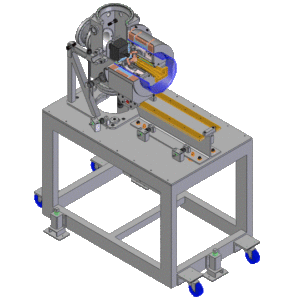Development of a Gas-Ion Source
NOSAMS has been exploring the capabilities of a gas-accepting microwave ion source originally built at the Atomic Energy of Canada, Chalk River Laboratories. The source uses 2.45 GHz microwaves and a continuously flowing stream of argon gas to sustain a plasma. Carbon containing gases mixed into the argon yield C+ ions that can be extracted as an ion beam. Negative ions are obtained by passing the beam through a magnesium charge-exchange canal. Initial success with this ion source has led to the design of a new gas-ion source.

Schematic drawing of the prototype gas ion source.
NOSAMS has been exploring the capabilities of a gas-accepting microwave ion source originally built at the Atomic Energy of Canada, Chalk River Laboratories. Specifically, the source is a microwave discharge ion source operated near the ECR condition (ECR = Electron Cyclotron Resonance, having an axial magnetic field in resonance with the microwave frequency).
Currently, the gas-accepting ion source is mounted on an ion-source test stand. The test stand consists of a combustion system, a gas-transfer system, the ion source, a charge-exchange canal, a double-focusing magnet, and two off-axis Faraday cups for the simultaneous measurement of mass-12 and mass-13 beams. The test stand has been useful in optimizing the gas-transfer system, the ion source, and charge-exchange canal.
Gas flows to the ion source via an open split followed by a 100-micron diameter, fused-silica capillary. By varying the length of the capillary, different gas flow rates can be selected. For maximum ion-source output, the optimal length of the capillary has been found to be 2.2 m. At this length, the measured CO2 gas flow rate was 240 µL/min, which agrees well with a calculated flow rate of 230 µL/min using Poiseuille’s equation.
Using a flow rate of 240 µL/min, C+ ion currents of 400 µA have been obtained with the charge exchange canal turned off. With the charge exchange canal turned on, C– currents of 63 µA have been obtained. The beam divergence was obtained by using two rotating-wire beam-profile monitors separated by 1.5 meters. With a beam extraction aperture of 5 mm, a half-angle divergence of 27 mrad (1.6°) was observed from a C– beam extracted at a beam energy of 30 keV. Divergence angles for C+ and Ar+ beams were essentially the same. Assuming a beam radius of 2.5 mm, this gives an approximate beam emittance of 12 ·mm·mrad·(MeV)1/2.
For tests, the ion source and charge-exchange canal were temporarily mounted in place of one of the standard sputter ion sources on the NOSAMS AMS system. Unfortunately, the angular divergence of the ion beam was large relative to that from the standard source. To avoid scattering of ions and charging of surfaces, a beam-limiting aperture with a diameter of 5 mm was installed at the object point of the injector system. Even with this limitation, C- beams as large as 22 µA were obtained. When pulses of CO2 produced by combustion of the Ox-I and Ox-II oxalic-acid standards were analyzed sequentially, the observed ratio of 14C/12C ratios was 1.27. Given the low total numbers of 14C ions collected, this result did not differ significantly from the accepted value of 1.29.
In collaboration with Atomic Energy of Canada, Chalk River Laboratories we are presently designing an improved version of the ion source with the aim of increasing the efficiency with which ions can be extracted. A picture of the new source design is shown below. Details of the source were examined and optimized through the use of the software PBGUNS. PBGUNS solves the Poisson equation for the region where ions are extracted from a plasma, in cases where the electric and magnetic field boundaries have a cylindrical symmetry. Magnetic fields were optimized using the software MagNet by Infolytica. Calculations indicate that at 40 keV extraction we should be able to obtain C+ ion currents of 1.3 mA.
Continuous-Flow Accelerator Mass Spectrometry (pdf version), 1st International Symposium on Radiation Physics, Mexico, December 1-3, 2003, submitted.
Presentations
A. Benthien, R.J. Schneider, K.F. von Reden, M.L. Roberts, J.M. Hayes, V.S. Griffin, J.S.C. Wills, A programmed-temperature combustion
system for continuous-flow AMS, 18th International Radiocarbon Conference, Wellington, New Zealand, September 1-5, 2003.
K.F. von Reden, M.L. Roberts, A. Benthien, R.J. Schneider, Computer modeling a microwave plasma ion source for 14C AMS applications. 18th International Radiocarbon Conference, Wellington, New Zealand, September 1-5, 2003.
M.L. Roberts, A. Benthien, R.J. Schneider, K.F. von Reden, J.M. Hayes, V. Griffin, and P. Long, A new facility for continuous-flow Accelerator Mass Spectrometry, 37th Symposium of Northeastern Accelerator Personnel, Strasbourg, France, October 13-16, 2003
Abstract submitted to the 16th International Workshop on ECR Ion Sources:
A Microwave Driven Ion Source for Continuous-Flow Accelerator Mass Spectrometry, J. Wills, R.J. Schneider, K. F. Von Reden, J.M. Hayes, M.L. Roberts, A Benthien, and B.X. Han, , to be presented at the16th International Workshop on ECR Ion Sources, Berkeley, California, September 26-30, 2004.
Abstract submitted to the 38th Symposium of Northeastern Accelerator Personnel:
A Microwave Ion Source for Continuous-Flow Accelerator Mass Spectrometry, M.L. Roberts, A Benthien, B.X. Han, R.J. Schneider K. F. Von Reden, J. Wills, and J.M. Hayes, to be presented at the 38th Symposium of Northeastern Accelerator Personnel, McMaster University, Hamilton, Ontario, Canada, October 17-21, 2004.
